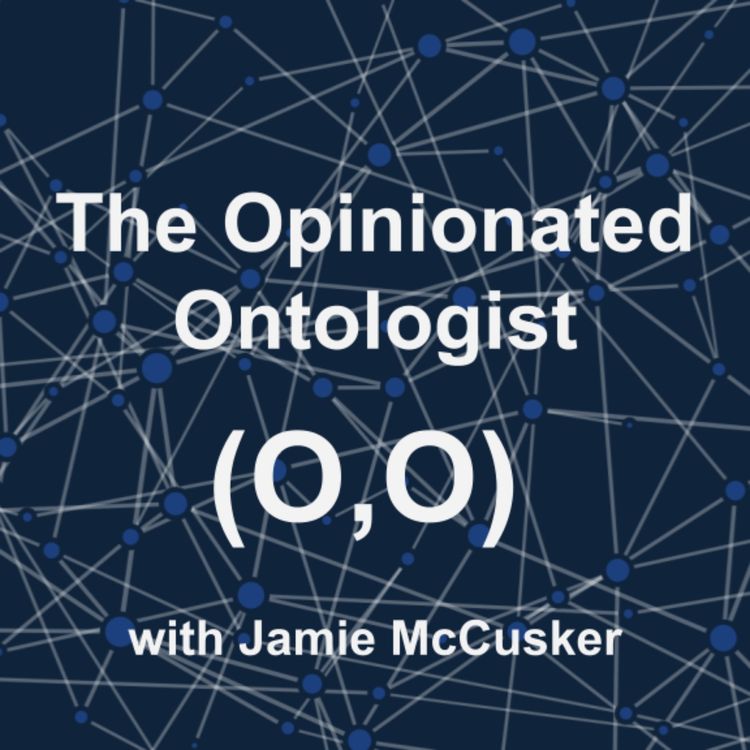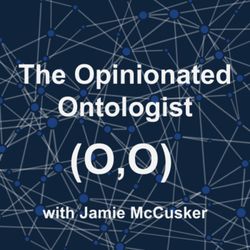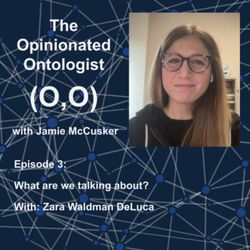Share

The Opinionated Ontologist
Upper Ontologies: gist
Season 1, Ep. 8
•
This week we discuss the upper level ontology gist with its creator, Dave McComb.
More episodes
View all episodes

11. What's in a Triple?
49:42||Season 1, Ep. 11We discuss reification using the W3C draf recommendation RDF 1.2, modeling choices, and how the approach is similar to, and different from, edge properties in Labeled Property Graphs.
10. KGC-palooza!
49:42||Season 1, Ep. 10This week I was at the Knowledge Graph Conference, the biggest industry Graph AI conference out there! I spoke with Bob Metcalfe of network effect fame, Peter Crocker of Oxford Semantics, and a huge KGC crew of ontologists, technologists, and knowledge graph experts. Featuring:Bob MetcalfePeter CrockerMara Inglezakis OwensMargaret WarrenPete RivettHande McGintyTom PlastererOra LassilaKeith CorbettElisa KendallLarry SwansonDeborah McGuinness
9. What's so Basic about BFO?
01:09:41||Season 1, Ep. 9We continue our mini series on upper level ontologies with an episode on the Basic Formal Ontology, or BFO. John Beverley of University at Buffalo joins us. John is the current steward of BFO, and works with its founder Barry Smith on its use in domain applications.For more information about BFO, visit their github page at https://github.com/BFO-ontology/BFO-2020.
7. What Does Medicine Mean?
53:00||Season 1, Ep. 7Chime Ogbuji joins me to talk about the role of medical informatics in knowledge graphs and semantics, all the way from MYCIN and GALEN to today.
6. Careful with that Predicate, Eugene!
22:08||Season 1, Ep. 6Properties are the workhorse of ontologies, where semantics really happen. So be careful when you make a new one!
5. What's So Hard to Understand?
01:19:15||Season 1, Ep. 5Keith Corbett and Grace Roessling join us for a discussion about learning RDF, OWL, and knowledge graphs.Keith: For nearly 50 years, Keith has been a technical communicator, data modeler, and knowledge engineer. Then and now, he has explored the intersections of deterministic AI, hypertext, and graph data. Grace: Grace is a PhD candidate cognitive science at Rensselaer Polytechnic Institute. in the Perception and Action lab with Dr. Brett Fajen. Her dissertation is focused on how humans combine vision and spatial knowledge to guide high speed steering. ReferencesLarkin & Simon (1987) -- list vs. diagrammatic representations (https://onlinelibrary.wiley.com/doi/pdf/10.1111/j.1551-6708.1987.tb00863.x)Temple Grandin (2016) -- visual thinking, pattern mathematical thinking, and verbal/auditory thinking (https://www.jstor.org/stable/26407108?seq=3)
5. What's an Ontology?
59:07||Season 1, Ep. 5In this episode, Deborah McGuinness and I discuss ontologies: what's in them, what they're used for, what makes them good, and how to go about making them.Notes and links:Deborah McGuinness: https://tw.rpi.edu/person/Deborah_L_McGuinnessThe Ontology Spectrum: https://www.researchgate.net/publication/221024668_Ontologies_Come_of_AgeSchemas vs ontologies: https://www.w3.org/wiki/SchemaVsOntology Ontology and database schema: What's the difference?Ontologies 101: https://protege.stanford.edu/publications/ontology_development/ontology101.pdfOntology Engineering: https://ieeexplore.ieee.org/book/8701593
3. What are we talking about?
01:00:37||Season 1, Ep. 3Today we flip the script: Prof. Zara Waldman DeLuca interviews Jamie on the fundamentals of knowledge graphs and ontologies, and they talk about some of the social, linguistic, and cognitive aspects of human vs machine cognition.